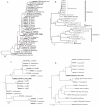Nodeomics: pathogen detection in vertebrate lymph nodes using meta-transcriptomics
- PMID: 20976145
- PMCID: PMC2956653
- DOI: 10.1371/journal.pone.0013432
Nodeomics: pathogen detection in vertebrate lymph nodes using meta-transcriptomics
Abstract
The ongoing emergence of human infections originating from wildlife highlights the need for better knowledge of the microbial community in wildlife species where traditional diagnostic approaches are limited. Here we evaluate the microbial biota in healthy mule deer (Odocoileus hemionus) by analyses of lymph node meta-transcriptomes. cDNA libraries from five individuals and two pools of samples were prepared from retropharyngeal lymph node RNA enriched for polyadenylated RNA and sequenced using Roche-454 Life Sciences technology. Protein-coding and 16S ribosomal RNA (rRNA) sequences were taxonomically profiled using protein and rRNA specific databases. Representatives of all bacterial phyla were detected in the seven libraries based on protein-coding transcripts indicating that viable microbiota were present in lymph nodes. Residents of skin and rumen, and those ubiquitous in mule deer habitat dominated classifiable bacterial species. Based on detection of both rRNA and protein-coding transcripts, we identified two new proteobacterial species; a Helicobacter closely related to Helicobacter cetorum in the Helicobacter pylori/Helicobacter acinonychis complex and an Acinetobacter related to Acinetobacter schindleri. Among viruses, a novel gamma retrovirus and other members of the Poxviridae and Retroviridae were identified. We additionally evaluated bacterial diversity by amplicon sequencing the hypervariable V6 region of 16S rRNA and demonstrate that overall taxonomic diversity is higher with the meta-transcriptomic approach. These data provide the most complete picture to date of the microbial diversity within a wildlife host. Our research advances the use of meta-transcriptomics to study microbiota in wildlife tissues, which will facilitate detection of novel organisms with pathogenic potential to human and animals.
Conflict of interest statement
Figures




Similar articles
-
Illumina MiSeq 16S amplicon sequence analysis of bovine respiratory disease associated bacteria in lung and mediastinal lymph node tissue.BMC Vet Res. 2017 May 2;13(1):118. doi: 10.1186/s12917-017-1035-2. BMC Vet Res. 2017. PMID: 28464950 Free PMC article.
-
Intestinal Microbial Community Dynamics of White-Tailed Deer (Odocoileus virginianus) in an Agroecosystem.Microb Ecol. 2017 Aug;74(2):496-506. doi: 10.1007/s00248-017-0961-7. Epub 2017 Mar 14. Microb Ecol. 2017. PMID: 28293696
-
Granulomatous inflammation in retropharyngeal lymph nodes of wild cervids in Saskatchewan.J Wildl Dis. 2009 Jul;45(3):625-30. doi: 10.7589/0090-3558-45.3.625. J Wildl Dis. 2009. PMID: 19617472
-
Bovine tuberculosis in a free-ranging mule deer (Odocoileus hemionus) from Montana.J Wildl Dis. 1995 Jul;31(3):432-5. doi: 10.7589/0090-3558-31.3.432. J Wildl Dis. 1995. PMID: 8592372
-
Chronic wasting disease of cervids.Curr Top Microbiol Immunol. 2004;284:193-214. doi: 10.1007/978-3-662-08441-0_8. Curr Top Microbiol Immunol. 2004. PMID: 15148993 Review.
Cited by
-
Polymorphic integrations of an endogenous gammaretrovirus in the mule deer genome.J Virol. 2012 Mar;86(5):2787-96. doi: 10.1128/JVI.06859-11. Epub 2011 Dec 21. J Virol. 2012. PMID: 22190723 Free PMC article.
-
Sequence divergence and conservation in genomes of Helicobacter cetorum strains from a dolphin and a whale.PLoS One. 2013 Dec 17;8(12):e83177. doi: 10.1371/journal.pone.0083177. eCollection 2013. PLoS One. 2013. PMID: 24358262 Free PMC article.
-
Metagenomic profile of the bacterial communities associated with Ixodes ricinus ticks.PLoS One. 2011;6(10):e25604. doi: 10.1371/journal.pone.0025604. Epub 2011 Oct 13. PLoS One. 2011. PMID: 22022422 Free PMC article.
-
NusG controls transcription pausing and RNA polymerase translocation throughout the Bacillus subtilis genome.Proc Natl Acad Sci U S A. 2020 Sep 1;117(35):21628-21636. doi: 10.1073/pnas.2006873117. Epub 2020 Aug 17. Proc Natl Acad Sci U S A. 2020. PMID: 32817529 Free PMC article.
-
A metatranscriptomic approach to the identification of microbiota associated with the ant Formica exsecta.PLoS One. 2013 Nov 18;8(11):e79777. doi: 10.1371/journal.pone.0079777. eCollection 2013. PLoS One. 2013. PMID: 24260298 Free PMC article.
References
-
- Rhyan JC, Spraker TR. Emergence of diseases from wildlife reservoirs. Vet Pathol. 2010;47:34–39. - PubMed
Publication types
MeSH terms
LinkOut - more resources
Full Text Sources

